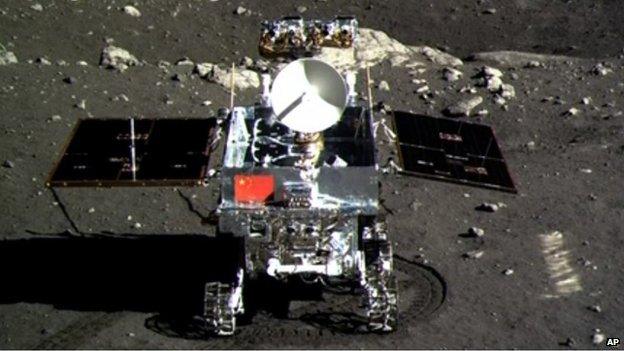'Remarkable' rocks within reach of Jade Rabbit rover
- Published

Images of the rover taken from the lunar probe were released by the Beijing Aerospace Control Centre
Some of the youngest lava flows on the Moon are within reach of China's Jade Rabbit rover, says a leading US lunar scientist.
The Chang'e-3 mission touched down on Saturday at the eastern edge of its designated landing box.
Dr Paul Spudis said the landing area was more interesting than its original destination and could fill in gaps in our knowledge of lunar history.
Meanwhile, officials have said that the rover's instruments are now working.
Five of the eight pieces of scientific equipment on Chang'e-3 had begun their observations, state-run Xinhua news agency said.
The telescopes and cameras are producing clear images, Zou Yongliao, a scientist with the Chinese Academy of Sciences, said at a press conference.
The lander and rover photographed each other on Sunday evening.
The Chinese craft performed the first "soft" landing (non-crash landing) on the Moon since 1976. And Jade Rabbit, or Yutu, is the first rover mission since the Soviet Union's Lunokhod-2 trundled through the grey soil 40 years ago.
A touch down had been planned in the Moon's Sinus Iridum (Bay of Rainbows). But the spacecraft actually landed on the northern edge of Mare Imbrium (the Sea of Rains) - visible on Earth as the right eye of the "Man in the Moon".
In a blog entry, external for the Smithsonian's Air and Space magazine, Dr Spudis, from the Lunar and Planetary Insitute in Houston, external, said: "Whether by design or fortuitous accident, this site is actually more interesting geologically than the spacecraft's original destination."

Chang'e 3 landed at the extreme northern end of a sequence of lava flows, which are estimated - by counting the number of impact craters on them - to be very young in lunar terms.
Dr Spudis said two major terrain types dominated lunar geology: the bright rugged highlands dating from the Moon's formation 4.5 billion years ago, and the younger "maria", dark volcanic plains made up of iron-rich lava flows.
The lavas began to erupt around 3.9 billion years ago, but it is unclear when this volcanic activity ended. The Mare Imbrium lavas appear to be between one and 2.5 billion years old, making them much younger than any of the rock samples returned from the Moon thus far.
Dr Spudis said the Imbrium lavas were "not only remarkable for their physical properties but are also compositionally interesting".
"Because the rover will examine several different individual areas during its traverse, we will obtain new "ground truth" data to better understand the meaning of data obtained remotely from orbit," he explained.
"At a minimum, Yutu will examine the composition of the surface lava flow."
Data gathered from orbit show the lavas to be high in the metal titanium. Volcanic flows to the north of the landing site seem to have a lower titanium content and appear to underlie the ones that Chang'e-3 sits on.
But some of these underlying rocks may have been excavated by impacts, allowing Jade Rabbit to look for them among the debris around craters.
"With data from the rover, we might be able to reconstruct the volcanic stratigraphy of this region of the Moon," said Dr Spudis.
"The Chang'e-3 lander and Yutu rover can provide many answers to our questions regarding the geological history of this region of the Moon and about lunar history in general."
China said it would launch Chang'e-5, a mission to return samples of rock and soil from the Moon, in 2017.
- Published15 December 2013
- Published14 December 2013
- Published14 December 2013
- Published1 December 2013
- Published29 November 2013
- Published24 June 2013
- Published11 June 2013